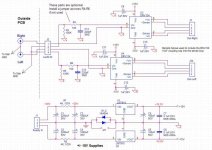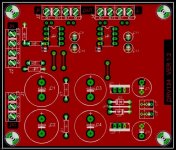alexw88 said:Have you checked you can buy the DRV134 chip now? Not many shops stock them. This is one of the reasons alexcd used OPA1632 instead.
there is always THAT1646. If you want to avoid the soic package, and keep it dip8. well the 1646 has a surface mount also.
I havent used the opa1632 as a line driver yet, but i just got some soic8 to dip8 adapters from ebay.
😀
Hi, the regulator may drop out due to lack of voltage on it's input pin.Algar_emi said:Please comment on this schematic and how can I improve it, or correct my mistakes, before I design the pcb.
The 4k (CRC) drops 20V on just 5mApk.
What is the quiescent in a pair of DRVs?
What is the peak current at your maximum signal into minimum impedance?
Maybe you should pre-regulate the 40V down to 30V, then you have protected the second from excess voltage and the first only has a 10V drop.
The pre-reg could float on the output voltage of the final reg. It might need a bypass Zener from input to output to cope with start-up conditions.
Thanks AndrewT for your comments. Yes, the 4K resistor was estimated using the quiescent current of the pair of DRV. However the exact value will be determine once it is all connected and working. I just want to reserve the space on the PCB for the resistor. Pre-reg is a good alternative, but maybe not needed in such a simple circuit. The CRC filtering has also they added benifit of reducing the ripple even further, as would do a pre-reg with its CMRR also, I know, but again more complex and a few dollards more.
Quote: "The pre-reg could float on the output voltage of the final reg"
Do you mean, like a Jung Regulator?
Thanks...
SB
Quote: "The pre-reg could float on the output voltage of the final reg"
Do you mean, like a Jung Regulator?
Thanks...
SB
I did not know Digikey had DRV134's in stock. I'll order some today! BTW, Algar, will you be selling these boards? I'm very interested.
digi01 has a real nice little drv134 board he sells with the regulators on the pcb. nice little compact unit and pretty cheap.
Thanks for the info. I'll probably do my own since I want both channels on the same PCB. Thanks anyway.
I'm making 4 mono channels (I have my work cut out for me.) Two would be a good idea to save on parts.
alexcd, i was happily surprised at how much the parts were for 4 boards at mouser. in the 100 dollar range minus trafo. i am ordering the solen caps from parts express at 4.00 apiece until i see how the lundahl thing progresses. i would really like to make a mono amp with 4 boards in the 400 watt range. i do not know how stable it would be.
tryonziess said:alexcd, i was happily surprised at how much the parts were for 4 boards at mouser. in the 100 dollar range minus trafo. i am ordering the solen caps from parts express at 4.00 apiece until i see how the lundahl thing progresses. i would really like to make a mono amp with 4 boards in the 400 watt range. i do not know how stable it would be.
Which boards are in the $100 range?
i was talking about all of the parts to populate alex88 boards. that is what i thought this thread was about bpa300 etc. my mistake. anyway i wish you luck with those small smd caps. i also had to wipe the board with alcohol to get the solder to take. it was not like previous pcb. i laid the lm3886 down flat and place the pcb against the sink. real neat and takes up very little real estate.
I am doing the same thing. It's very nice. My parts were significantly more but I lost track of all the extras I had to buy.
alexcd, all of the extras---you can never seem to keep it to just a few. how hard do you think it would be to design a postage stamp size servo circuit with smd parts to add on to the bpa 150 boards. it might even be the size of a dime. the circuit does so many little nice things and is cheap. do you have to check offset at each chip or all at the speaker output.
You would need to check it all outputs. That definitely should have been implemented but I don't suggest trying now. I dont have a board making capabilities to do 24 micro boards (they would be small for sure.) Any opamps would undoubtedly use +/-15V as well so a power supply is required too.
alexcd said:You would need to check it all outputs. That definitely should have been implemented but I don't suggest trying now. I dont have a board making capabilities to do 24 micro boards (they would be small for sure.) Any opamps would undoubtedly use +/-15V as well so a power supply is required too.
They don't need much power though, you could probably just feed it with a pair of zeners and resistors (maybe caps too).
At least that's how I'm planning to do mine.
Inefficient, but pretty insignificant on a 300W amp.
-Nick
- Status
- Not open for further replies.
- Home
- Amplifiers
- Chip Amps
- Driver chips for BPA300 amplifier


